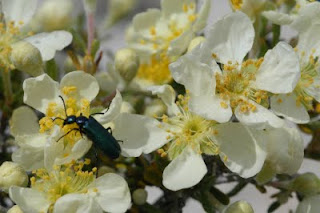
This photo was taken a few springs ago in Burro Creek in Western Arizona. Burro Creek is in a wilderness area. Southeast of there, on the horizon in the photo, is a mountain of mine waste from a copper mine near Bagdad, Arizona.
The "Where You At" series asks this question:
14. What species have become extinct in your area?
As a biologist, I would rewrite this question to ask:
What species are currently at risk of extinction in your area?
I rephrase this because extinction is actually the norm for life on Earth. Paleontologists estimate that more than 99% of all species that have ever existed are now extinct, victims of massive events that changed the planet's climate. Six major extinction events are recorded in the annals of biological life, the last of which is occurring today. Right now. Extinction is generally a very slow process that occurs over hundreds or thousands of years. When populations of a species become scattered, small and/or concentrated, that is when a cataclysmic event can wipe them out forever.
In the state of Arizona, the Fish and Wildlife Service has fifty four species of animals and seventeen species of plants listed as threatened or endangered, or at risk of becoming extinct unless carefully managed and protected. In addition to these "T&E" species, there are hundreds more that are considered "rare" or "sensitive," meaning that populations are stable now, but that habitat and distribution is limited. Most often the causes of rarity for TES (Threatened, Endangered or Sensitive) species are habitat fragmentation, habitat destruction, or, as in the case of many fish species, radical habitat alteration. Today, most significant changes to habitat are due to the activities of humans.
So, the answer to the first question is, "Too many to count or record!" But we could just give one recent example of wolves, which used to range into the Phoenix area, but have been extirpated by government sanctioned hunting so that they now occur only in the most southern ranges of Arizona. Ironically, their existence in Arizona today is also courtesy of the same government that set out to exterminate them. Only now we are attempting to reintroduce them. Unfortunately, at the same time, there are still people who would rather ensure their extinction, a mindset I cannot fathom.
The answer to the second question could be "all species" if you are inclined toward catastrophic thinking. But I am not so morose. I believe that life will always find a way. After each of the major extinction events, life has always evolved into more diverse, abundant and magnificent forms. The biological communities we have today are entirely different than the ones that thrived right here one hundred million years ago. The current extinction event will most likely play out in a similar way. Whether humans are around to observe what happens a thousand years from now is a big question that we cannot answer. Rather than descend into speculative discourse on the Holocene extinction, I'll just feature two species that are on Arizona's list of rare plants.

One is Agave murpheyi, or Hohokam agave. The most interesting fact about this species is that they are documented in the wild only where former agricultural areas were managed by ancient peoples that once subsisted in the Phoenix area. The Hohokam people used the plant for food, fiber and trade. Today, these plants are cultivated at local nurseries for ornamental purposes, so "trade" in Agave murpheyi continues in earnest! In fact I "traded" a five dollar bill for one that now grows in my yard, shown above. The wild populations that remain may have been originally established by Hohokam communities from young plants or "pups" that were imported from Mexico. So here is an example of a species we dub "rare" in our area because there are few small scattered populations, but the reason these populations exist at all is because people imported them! Very interesting indeed!

Another rare plant that I have visited is Purshia subintegra, or Burro Creek Cliffrose. There are four populations known only in Arizona, the largest of which is in a heavily populated area just north of Phoenix in the Verde Valley. Burro Creek Cliffrose is listed as endangered, and is threatened by urbanization, mining, overuse by cattle and burros, road construction, off-road vehicle traffic and extended drought. They are also limited to habitats where there are limestone outcrops. Unlike the Hohokam Agave, there are no known uses to humans other than possibly as an ornamental landscaping plant. But because of its intrinsic value as a unique species, humans are working to ensure that this species does survive in the wild, by salvaging plants that wind up in the path of urban development and by cultivating them for reintroduction into native habitat. The pictures I have of this plant were taken in Burro Creek, south of Kingman. The shiny blister beetle that is visiting the flowers coexists, and may be partly dependent on this plant. Such is the web of life!


So it is on both ends of the spectrum that human civilization influences individual species and entire biological communities. We wipe them out. We preserve and facilitate their continued existence on Earth. How we conduct our lives, both as individuals and communities, will determine the fate of not only our own species, but of millions of others that creation/evolution has graced our planet with.
More information on TES species in Arizona can be found at the US Fish and Wildlife Service website:
http://ecos.fws.gov/tess_public/pub/stateListingAndOccurrenceIndividual.jsp?state=AZ
And at the Arizona Natural Heritage Program page for the Arizona Fish and Game Department:
http://www.azgfd.gov/w_c/edits/species_concern.shtml







2 comments:
I have often imagined what the landscape I'm in right now would look like 100,000 years from now. 100,000 years is a long time to humans but just a blink in geologic time.
Post a Comment